Raising sheep can be a satisfying venture since most breeds are adaptable. Although they require more management than beef cattle, sheep production still has relatively low labor requirements and lower investment costs.
There are several breeds you can choose for starters—an ideal choice would be the Dorset horn sheep.
Dorset horn sheep are medium-sized, white-fleeced livestock primarily raised for their meat quality but can also produce quality milk and wool. Since they have a calm and docile nature, they can also be barnyard animals or pets.
This article discusses everything you need to know about dorset horn sheep, their history and origins, their physical attributes, distinctive characteristics, and other interesting information. Read further for more!
Dorset Horn Sheep History

Exact origins are currently unknown but it is speculated that the Merino sheep, characterized by its white face, horns, and short-length wool, were introduced in Southwest England by the Spanish and were then crossbred with the horned sheep of Wales to produce an ideal, all-purpose sheep necessary at that time.
The Dorset horn sheep was brought in through shipments from the West Coast of England to Oregon in 1860, specifically for Mr. Richard Scott from Milwaukee.
In 1885, additional shipments of the sheep were brought to the East Coast and were exhibited at the American Fat Stock Show in Chicago. Between 1887 to 1891, there were 5 more shipments.
Polled Dorset horn sheep were a result of a mutation of the Horned Dorset at North Carolina State College. It wasn’t until researchers confirmed that both the Polled and Horned Dorsets carried the same genetic characteristics that they were accepted into the United States Registry in 1956.
The population of Polled Dorset exceeds those of the Horned variety, not just in the U.S. but also worldwide.
Today, the Continental Dorset Club, the official registry office for the Dorsets, holds two exhibitions annually—the National Junior Dorset Show and the International Dorset Show at the North American Livestock Exposition.
What Is a Dorset Horn Sheep?
What Do Dorset Horn Sheep Look Like?
White, medium-sized sheep with open faces, elongated bodies, and great muscle formation. Its fleece is strong, relatively fine, and free from any dark fibers.
Both rams (male sheep) and ewes (female sheep) have forward-curving horns, but while the ewes’ horns are lightweight, rams’ horns are heavy and also tend to spiral out more.
How Long Does a Dorset Horn Sheep Live?
The average lifespan of the Dorset horn sheep is 10 to 12 years, but they can live as long as 20 years. Ewes are known to be highly prolific as they can produce lambs that have a relatively long life expectancy.
What Do Dorset Horn Sheep Eat?
Dorset horn sheep are considered herbivores, which means they primarily eat plant material. They usually spend their time grazing on weeds, grass, forbs, silage, legumes, hay, roughage, and other natural forage.
They also consume grain, but too much of it can cause gastrointestinal problems such as bloating.
How Big Do Dorset Horn Sheep Grow?
Dorset horn rams can reach up to 37 inches at shoulder height, while females can be up to 34 inches.
Are Dorset Horn Sheep a Heavy Breed?
Dorset horn sheep are not a heavy breed. They are average compared to other sheep breeds. Rams weigh a range of 225 to 275 pounds, while ewes weigh around 150 to 200 pounds.
What Is Dorset Horn Sheep Known For?
Dorset horn sheep are popularly known for their meat since they can produce a desirable carcass due to their muscle conformation and good body length.
They also produce wool, free from dark pigmentation, and have a diameter ranging from 27 to 33 microns, making it a highly versatile, medium-grade wool. Additionally, they make a considerable amount of milk too.
Where Do Dorset Horn Sheep Originate?
They originate from the lush hill pastures and sheltered valleys of Southwestern England. However, it is believed that they were a result of a crossbreed between the Merino sheep, owned by the Spanish, and the horned sheep of Wales.
What Are the Distinct Characteristics of a Dorset Horn Sheep?
Dorset horn sheep ewes are known for their excellent reproductive, mothering, and milking abilities. In fact, they are the only British breed capable of breeding even throughout winter.
Dorset Horn Sheep Temperament
Dorset horn sheep have a calm, docile nature and can be easily bucket-trained. Dorsets are also highly active and hardy.
Are Dorset Sheep Good for Meat?

Dorset horn sheep are good for meet. They are primarily raised for their carcass size and superior meat quality, as they can produce premium-grade mutton, lamb, and hogget.
Do Dorset Sheep Need Shearing?
Dorset horn sheep do need shearing. Almost all sheep breeds need shearing at least once a year.
Dorset horn sheep particularly should be sheared during the spring. But generally, they can be sheared at any time as long as they have enough wool to keep them warm during the winter frost. Timing is an important factor to consider when shearing this breed.
How Much Does a Dorset Horn Sheep Cost?

As of this writing, a Dorset horn sheep can cost anywhere around $180 to $966, depending on the age, variety, and sex, as well as if they have been shorn once, referred to as shearlings, and if they are officially registered.
Are Dorset Horn Sheep Good Pets?
Dorset horn sheep are good pets. They can be kept as barnyard animals in ranches and farms due to their docile nature.
Tips for Taking Care of Dorset Horn Sheep
1. Housing
An old barn or shed can provide excellent shelter for sheep, so it doesn’t need to be expensive.
However, expect a few renovations to better cater to the operations and management of the sheep, such as providing good ventilation and preventing too much moisture and wind. Fabric structures and calf hutches can also work.
Housing is necessary during the winter months to keep the sheep dry and warm. During the summer, shelter is not needed although some of your sheep may seek protection from the sweltering heat. Ensure that the housing is big enough for them to move around, as sheep hate tight, closed spaces.
2. Equipment
Purchase feeders so that the sheep won’t eat feed off the ground, which may cause health problems such as parasitic infections, and also prevent any spillage.
Additionally, provide clean and sufficient water in a container such as troughs and buckets. You can also choose automatic watering systems for convenience.
3. Feeding and Nutrition
Lambs will need rations that contain around 16 to 18 percent of protein to allow optimum muscle development. During their fattening stage and also in the hot summer months, they can be fed with a lower amount of protein to reduce heat stress.
Older animals, on the other hand, can be fed rations consisting of 11 to 12% protein.
Since forages may not be sufficient enough to complete the animal’s necessary nutritional requirements, additional sources of energy and protein may be added to their diets, such as soybeans or soybean meal, fishmeal, linseed meal, and cottonseed or cottonseed meal.
You can also add grain sources such as barley, corn, spelt, oats, and wheat but limit the amount since too much is unhealthy for the sheep.
4. Pasture Systems
Dorset horn sheep must be given enough pastures to graze throughout the spring, summer, and fall seasons. Pasture height should be well-maintained to prevent any parasitic infections.
There must also be a perimeter fence consisting of either woven wire fencing or electric wiring that can contain the sheep inside the pasture and simultaneously keep any predators out.
5. Shearing
Allow your sheep to be sheared by a professional at least once a year to prevent the buildup of urine, manure, and other dirt that can lead to infections, as well as create a sterile environment for newborn lambs.
6. Healthcare
Routine healthcare practices should be exhibited, which include deworming, tagging, castrating, docking, and vaccinating. Make sure you hire trained professionals or local veterinarians with experience to do so.
Is It Expensive to Raise Dorset Horn Sheep?
Aside from the initial expense of buying the actual sheep, raising them can incur low to almost no costs, depending on the type of housing and equipment you construct for them.
You can earn the money you spent back when you sell them according to the market you prefer (meat, wool, or milk).
How Much Space Does a Dorset Horn Sheep Need?

- Creep feeder: 8 to 12 inches per lamb
- Feeder space: 9 to 12 inches per head depending on the size of the ewe, feeding schedule, and if they are shorn or unshorn, pregnant or otherwise.
- Ewes for flushing: 10 to 14 square feet per head
- Ewes with lambs: 16 to 20 square feet per ewe-lamb pair
- Weaned lambs: 8 to 10 square feet per head
- Lambing pens: 16 square feet per pen
- Rams: 20 to 30 square feet per head
Related Questions
What Type of Wool Do Dorset Sheep Have?
Dorset horn sheep have medium to broad wool since they have a range of 27 to 33 microns. This measurement indicates that their wool is firm and dense, which makes it ideal to use in blankets, sweaters, hats, and more.
What Do You Feed Dorset Sheep?
Allow them to graze for weeds, grass, forbs, silage, legumes, hay, roughage, and other natural forage.
Grain is also acceptable as long as it is only limited. You can also feed them commercial sheep diets that have complete nutrient requirements.
How Often Should You Worm Your Sheep?
Only when they need it since allowing sheep to get dewormed preventively or based on a routine schedule can cause the worms to develop resistance against the antiparasitic drugs. This is why they should be given to treat any parasitic disease instead of using it as a preventive measure.
How Many Pounds of Hay Does a Sheep Need?
About 4 to 5 pounds per sheep per day. However, you have to observe if the animals will eat the entire amount given to them. If not, reduce the amount of hay you give them.
List of Sources
So You Want to Raise Sheep or Goats?
